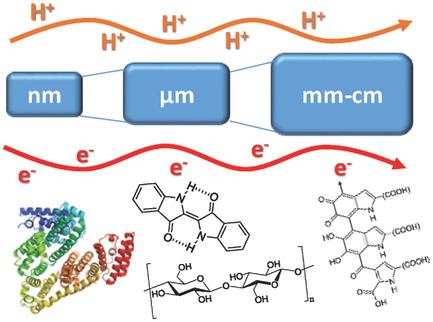当前位置:
X-MOL 学术
›
Adv. Mater.
›
论文详情
Our official English website, www.x-mol.net, welcomes your
feedback! (Note: you will need to create a separate account there.)
Macroscale Biomolecular Electronics and Ionics
Advanced Materials ( IF 27.4 ) Pub Date : 2018-10-17 , DOI: 10.1002/adma.201802221 Nadav Amdursky 1 , Eric Daniel Głowacki 2, 3 , Paul Meredith 4
Advanced Materials ( IF 27.4 ) Pub Date : 2018-10-17 , DOI: 10.1002/adma.201802221 Nadav Amdursky 1 , Eric Daniel Głowacki 2, 3 , Paul Meredith 4
Affiliation

|
The conduction of ions and electrons over multiple length scales is central to the processes that drive the biological world. The multidisciplinary attempts to elucidate the physics and chemistry of electron, proton, and ion transfer in biological charge transfer have focused primarily on the nano‐ and microscales. However, recently significant progress has been made on biomolecular materials that can support ion and electron currents over millimeters if not centimeters. Likewise, similar transport phenomena in organic semiconductors and ionics have led to new innovations in a wide variety of applications from energy generation and storage to displays and bioelectronics. Here, the underlying principles of conduction on the macroscale in biomolecular materials are discussed, highlighting recent examples, and particularly the establishment of accurate structure–property relationships to guide rationale material and device design. The technological viability of biomolecular electronics and ionics is also discussed.
中文翻译:

宏观生物分子电子学与离子学
离子和电子在多个长度尺度上的传导对于驱动生物世界的过程至关重要。阐明生物电荷转移中电子,质子和离子转移的物理和化学的多学科尝试主要集中在纳米级和微米级。然而,最近在生物分子材料方面取得了重大进展,该材料可以支持超过毫米(即使不是厘米)的离子和电子电流。同样,有机半导体和离子中类似的传输现象也导致了从能量产生和存储到显示器和生物电子学的广泛应用中的创新。在这里,我们讨论了生物分子材料中宏观导电的基本原理,重点介绍了最近的例子,特别是建立精确的结构-属性关系以指导基本原理的材料和设备设计。还讨论了生物分子电子学和离子技术的技术可行性。
更新日期:2018-10-17
中文翻译:

宏观生物分子电子学与离子学
离子和电子在多个长度尺度上的传导对于驱动生物世界的过程至关重要。阐明生物电荷转移中电子,质子和离子转移的物理和化学的多学科尝试主要集中在纳米级和微米级。然而,最近在生物分子材料方面取得了重大进展,该材料可以支持超过毫米(即使不是厘米)的离子和电子电流。同样,有机半导体和离子中类似的传输现象也导致了从能量产生和存储到显示器和生物电子学的广泛应用中的创新。在这里,我们讨论了生物分子材料中宏观导电的基本原理,重点介绍了最近的例子,特别是建立精确的结构-属性关系以指导基本原理的材料和设备设计。还讨论了生物分子电子学和离子技术的技术可行性。











































 京公网安备 11010802027423号
京公网安备 11010802027423号